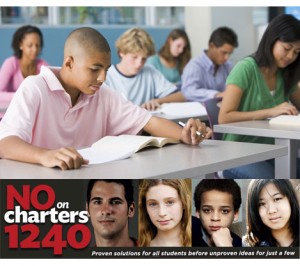OPINION
I-1240 charter schools divide our students, communities
In a landmark address in 1988, former American Federation of Teachers (AFT) President Albert Shanker became one of the first education leaders to promote the concept of charter schools.
However, the vision Shanker had for teacher-led laboratories of reform is not at all what has happened with charter schools in our nation, which largely feed children canned curriculum, not a rich menu of creative learning experiments. In Shanker’s vision, unions were essential to charter schools, because unions help create the kind of secure work environment that encourages and allows teacher innovation and risk-taking. But the reality of current charter schools is to get rid of teachers’ unions.
As a professional education organization, AFT nationally represents public school teachers, although not in Washington State. Like our colleagues in the Washington Education Association, AFT members fight to protect our students from the damage that charter schools have done in other states and stand opposed to I-1240.
The initiative makes its purpose clear: it will “allow public charter schools to be free from many regulations so that they have more flexibility… to hire and fire teachers and staff.” There is something so callous about that word “fire.” There is no sense in this initiative of how teachers will be treated, no sense that they are valued, no feeling that they will be intimately involved in the creation of the schools (unless some number of them decide to start a charter themselves — an unlikely occurrence.) But perhaps it is this circumstance — the ability to fire staff easily and likely under-pay them — that allows the initiative writers to say, with no realistic basis whatsoever, that “public charter schools will create efficiencies in the use of the resources the state provides to school districts.”
 Few charters engage in rigorous evaluation, but even if they do, it is not transparent. In other states they have not led to new models for public schools. Often this is because there are no new models to spread (after all, studies show 48% of charters do no better than comparable public schools and 37% do worse). When charter schools are successful, it can be because money is donated by private entities. This is happening here now to fund the pro-charter school initiative. Indeed, Bill Gates just contributed another $2.2 million and Alice Walton gave another $1.1 million to help pass I-1240. You have to ask why.
Few charters engage in rigorous evaluation, but even if they do, it is not transparent. In other states they have not led to new models for public schools. Often this is because there are no new models to spread (after all, studies show 48% of charters do no better than comparable public schools and 37% do worse). When charter schools are successful, it can be because money is donated by private entities. This is happening here now to fund the pro-charter school initiative. Indeed, Bill Gates just contributed another $2.2 million and Alice Walton gave another $1.1 million to help pass I-1240. You have to ask why.
In other states, charter schools do not serve the full range of students that public schools must serve. The laws that found them always say that they may not limit admission, but they do not have to keep every child that enrolls. According to a StateImpact/Miami Herald investigation as reported by NPR, 86 percent of charter schools in Florida do not have any students who are severely disabled despite the fact that state and federal laws require charter schools to give equal access to these students. There is no guarantee that charter schools in Washington will keep the students they may be required to take, effectively allowing charter schools to keep the easier students and reject the students they don’t want.
There is no reason for Washington to follow other states in allowing a publicly funded, privately run form of “public school” that separates children rather than uniting them. The achievement gap needs to be closed. It needs to be closed for all our children.
If charter schools were doing it, there would be every reason to support them, as Al Shanker had imagined their potential. But they are not and they offer no other possibility for improving our children’s education. We already have innovative public schools. We need to fully fund them before we start creating boutique alternatives, dividing communities at a time when it is important for everyone to work together.
Sandra Schroeder is President of AFT Washington and Vice President of the Washington State Labor Council, AFL-CIO.






